Content Marketing for Startups – The Step-By-Step Guide for Tech Companies

Content marketing for startups is a thorny topic. But it’s also one of my favorite topics because there is no one-size-fits-all here.
Have you asked yourself whether you need to blog or not? What about live streaming — is it worth it? How many times should you post on your social media channels? What other types of content should you post?
We will answer all these questions and many others in this post.
After reading it, you will be able to decide what the size that fits your startup is and how to tackle content marketing to get excellent ROI.
You will also get an easily customizable framework to create your content marketing strategy.
Here’s what we’re going to cover in our comprehensive guide on content marketing for startups:
- What is content marketing?
- What is content marketing for tech startups?
- Are there any downsides to content marketing for tech startups?
- How to create your very own content marketing strategy
Ready?
Let’s start learning!

GIF via GIPHY
1. What Is Content Marketing?
Content marketing is a marketing tactic that involves creating, publishing, distributing and promoting highly-relevant, well-thought and valuable content to the right audiences. Content marketing does not overtly promote a brand or a product but its long-term goal is to generate interest in the said brand or product and, ultimately, stimulate profitable customer actions.
See the emphasized words above? They are key to the success of any content marketing strategy.
Here’s the thing: content marketing isn’t just promoting your content. And it isn’t just publishing content.
It’s a mix of publishing and promoting.
And you need both of these because:
- No amount of promotion can save mediocre content
- Over 4 million blog posts are published every day. You can’t expect to hit publish and wait for your article to be discovered
- Balance is key: overpromoting your content will annoy people. Underpromoting it will bring zero traffic and engagement.
Since we’re here, let’s set one thing straight: content isn’t just blogging. Pretty much everything you publish can fall under content.
More importantly, content isn’t only in the form of the written word. Videos, infographics, and podcasts are also types of content.

Image via SmartInsights
Except for landing pages, sales pages, ad copy and other forms of copywriting.
Confused about the difference between copywriting and content writing? We’ll tackle this at length in an upcoming blog post but in the meantime, here’s a short overview.
Copywriting is a form of advertising. It’s designed to sell and do it as fast as possible.
Content writing is not advertising. Content writing informs, entertains, and explains. It can play a significant part in converting readers or viewers into paid customers but it’s not advertising.
The best content provides solutions to readers. And it guides them toward realizing that your startup is the solution they’ve been looking for.
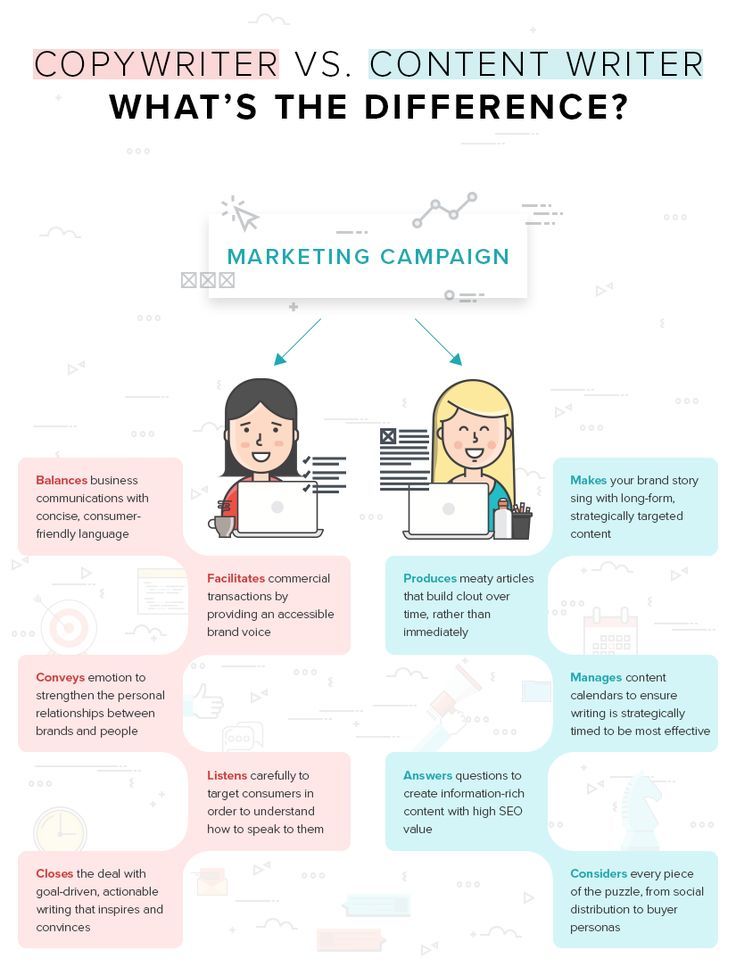
Image via Pinterest/MarketingProfs
At Copywritech, we strongly believe that content writing should be aligned with your marketing and business goals. In other words: that it should have a central role in your sales funnel (you’ll see how to achieve this below).
To sum it up, we can say that content can (and should!) also sell but in a more subtle way.
Need proof?
Cazoomi converts 25% more leads through content written by Copywritech. They also generate 50% more leads — also through content alone. Click to read the full case study and understand how we made it happen for them!
OK, now that we know what content marketing is and what it isn’t, let’s take a look at why you should be bothered with it.
Why Do You Need Content Marketing?
I’ve built two brands, Idunn and Copywritech, on content marketing and SEO alone. I know content marketing works.
It worked for us and it worked for all our clients.
But I also know that numbers speak louder than anything. So let’s take a look at some numbers, research reports, and stats.
1. The average customer is fed up with ads
5000 ads. That’s how many ads an average person sees EVERY DAY. This overexposure has led to banner blindness or ad blindness — a phenomenon in which web users ignore anything on a website that resembles an ad or a banner. This is done both consciously and subconsciously.

Image via Adotas
Banner blindness leads to extremely wasteful media buys aka paying for ads that people simply ignore. Ad blindness is also damaging brand trust.
More than 30% of ALL internet users have an ad blocker installed. Thus, even if they might be interested in your ads, they won’t even see them.
Here’s why they DON’T want to see your ads:
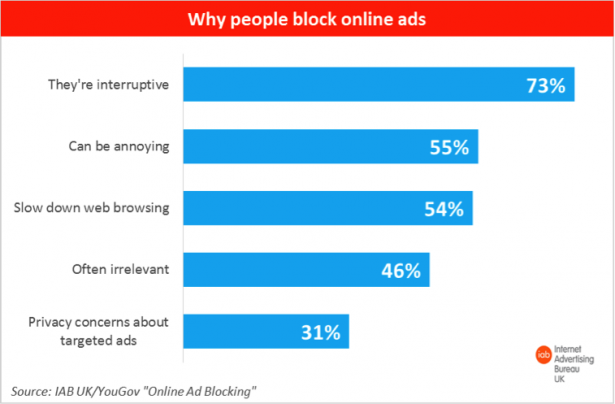
Image via Clickz
So tell me again why you are spending your marketing budget on ads?
Here’s what happens on the other side of the aisle:
2. Customers prefer to get to know a brand through content
78% of customers have said that they prefer content over ads.
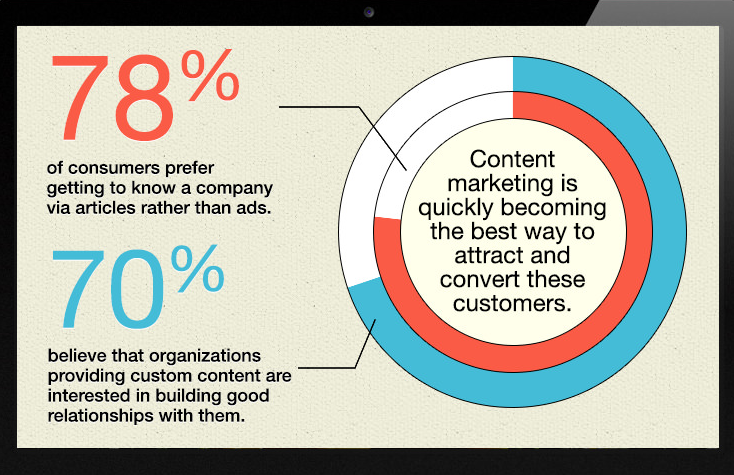
Image via Lyfe Marketing
And 70% of customers say that the right content helps to build trust.
This is why content marketing is even more important for startups than for established brands. Startups have yet to build a reputation and establish themselves as industry experts.
There’s no better way to do this than through content marketing.
3. Content is cheaper and more effective than advertising
Right, so it’s not just the customers who prefer content marketing but also the marketers themselves.
It turns out that content marketing costs 62% less than traditional marketing and generates three times more leads.
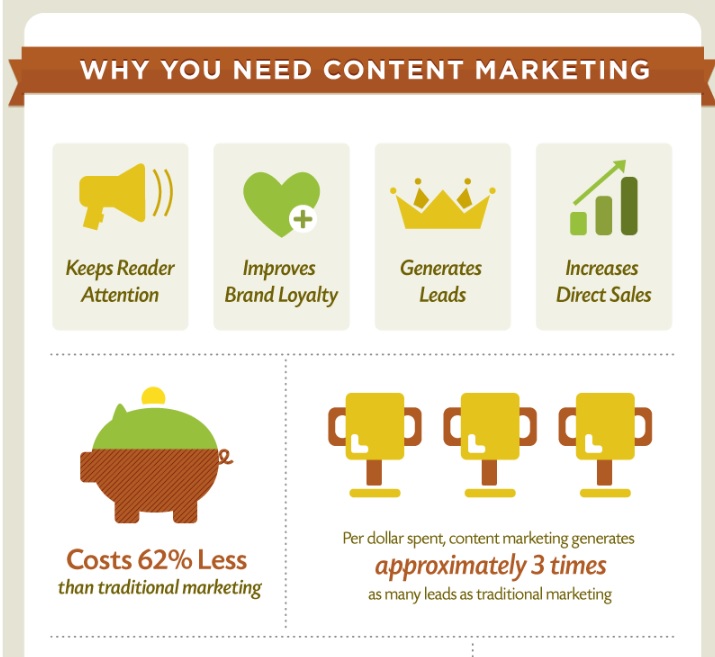
Image via Demand Metric
Talk about a bang for your marketing buck, right?
4. Content sells
61% of U.S. consumers have made at least one purchase based on recommendations on a blog.
There are hundreds of stats and statements from seasoned marketers that say the same thing: content marketing works. I can’t list them all here (this is not the purpose of this article), but you can check 10 more stats here.
Since we now know that content marketing works, let’s take a look at its specifics for tech startups.
2. What Is Content Marketing for Tech Startups?
How is content marketing for startups different than “regular” content marketing?
Well, the differences are related to the approach more than to substance.
With online ads growing more expensive each year, startups need a way to get their brand out there. And fast.
Sure, content isn’t as fast as ads but it’s cheaper and more effective (as seen above).
So the difference in approach when it comes to c0ntent marketing for startups lies in the amount and the quality of content they publish and promote.
While an established company can afford to publish less frequently, a startup should always stick to their content calendar and publish and promote more than its competitors.
Similarly, quality should never be anything below excellent.
Now, I would never advocate for mediocre content. I’m not saying that an established tech company can afford to push crappy content as a rule.
What I’m saying is that if this happens, it’s not that big a tragedy as it can be for a startup.
When people know that your company is a source of excellent content, they won’t cancel their newsletter subscription just because your last piece was meh. They’ll give you a second chance. Perhaps even a third or a fourth.
But that’s because they already know you. They know they can trust you. And they know that everyone makes mistakes.
However, if they don’t know you, you won’t get a second chance.

GIF via GIPHY
Remember that there are millions of blog posts published each day. Nobody has time for mediocre content anymore.
As a startup, you have one chance to impress your audience with excellent, authority-building content. You don’t want to waste that.
To sum up, content marketing for startups:
- Needs more clarity (it should always be mapped to business goals)
- Has a stricter publishing schedule (no missed deadlines)
- Has better quality (no publishing “just for fun” and no taking chances on risky or controversial topics)
- Is always aligned with user intent (excellent knowledge of the buyer persona is required; no “random acts of content”)
- Gets more promotion than content for established companies (remember that this is the phase where you are still testing channels to see which ones work best).
- Is more educational (hiring tech writers that know how to translate your technology into benefits for the customer is essential)
Other than that, relevance and added value remain the key elements of content marketing, even for brand-new startups.
3. Are there any Downsides to Content Marketing for Startups?
Content writing for tech startups is our top-selling service. I could easily tell you that there are NO (zero, nada, zilch) downsides to content marketing for your startup.
It’s quite tempting.
But it’s also not true.
There are downsides to it, just like there are downsides to every marketing tactic out there.
The job of a great marketer is to minimize those downsides and leverage the advantages.
Or, when the former clearly outweighs the latter, to know when to let go of a tactic that doesn’t bring enough ROI to justify the spend and the effort.
So, what are some of the downsides to content marketing for startups?
- It takes time: just like Rome wasn’t built in a day, neither was ROI from content marketing. It can take months or even up to a year to see significant ROI from content.
- You need to start early: precisely because content takes time, you should start early on. Ideally, you should have a few blog posts pre-written before the launch and your social media channels up and running before your website goes live.
- It’s not cheap: sure, it’s cheaper than paid ads but this doesn’t make it cheap-cheap. As outlined above, you must invest in quality content from the get-go. And quality is never cheap.
- Writing takes time: a great blog post can take days, or even weeks to write. Bootstrapping startups rarely have that time. But you can always outsource your content writing to professionals (it’s cheaper AND more efficient). I know a company that specializes in writing for tech startups — *wink-wink* — you can check out our pricing plans and drop us a line anytime.
- Results aren’t easy to measure: which part of your blog post determined the reader to subscribe to your newsletter? How many articles are too many? Or too few? There is no one-size-fits-all here. It’s all about testing and then testing some more.
- It can be hard to find the right topics: the first entries in your content calendar seem like a walk in the park. But the more time passes, the harder it is to come up with new topics that match both user intent and your business goals.
In my experience, time and money are the top concerns of startup founders. Their small teams can’t afford to take on a new task, especially one as time-consuming as content writing.
Hiring someone just to do the writing can put a huge strain on an already stretched budget. So outsourcing becomes the most viable option for startups.
It’s no wonder that 84% of successful B2B marketers outsource content writing.
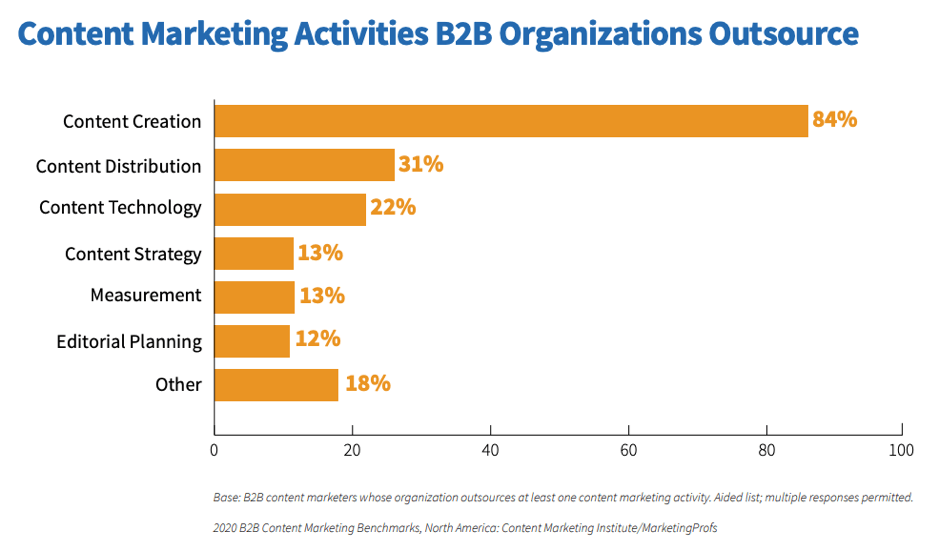
Image via Smart Insights
Bottom line: most of the downsides of content marketing for startups are easy to mitigate. However, especially in the early stages of a startup launch, content cannot be your only marketing strategy.
For instance, who’s going to read a brand-new blog?
This is why you will need to correlate your content marketing efforts with other promotional tactics, like social media ads. You don’t have to invest a fortune. Even a smidge of a budget is enough for your posts to stimulate organic reach on social media channels.
4. How to Create Your Very Own Content Marketing Strategy
This is the part you’ve been waiting for, right?
We’ll get to it shortly but before we do you might want to also check out our blog post on how to create a SaaS content strategy. Bear in mind, though, the post above is only about content strategy, not about content marketing strategy as a whole.
This means that the guide below is way more comprehensive, as it includes the promotional side of content marketing for startups too.
OK, enough chit-chat. Let’s dig in.

GIF via GIPHY
1. Get to Know Your Buyer Persona
You can neither create content nor promote the content you’ve created without knowing who it’s for, right? It’s like writing a letter with a blank space after “Dear…” and then shoving it in the mailbox without any address.
Shooting in the dark is not a strategy. And no tech startup can afford to create a product that’s for everyone.
The same goes for content.
If your content is for everyone, it’s really for no one.
Luckily, the early stages of a startup are the perfect time to outline whom you’re writing for. After all, you already have a buyer in mind for your technology, right?
Go back to that.
Think about:
- Who will your technology help?
- How will your technology be used by your clients?
- What problems does your solution solve?
- What other complementary solutions does it work with?
You must know the answers to all these questions from the drawing board of your solution itself. Answering them in great detail will help you build your content marketing buyer persona.
These answers should help you know:
- Your audience’s pain points
- How tech-savvy they are — do you need to create content about how to use your technology, or do you simply need to explain why they need it?
- Where they live
- What is their preferred tone of voice
- What other similar or complementary products they use
Remember: no detail is insignificant.
For example, if you’re selling a SaaS security solution, you may think that it’s irrelevant whether your audience shops at Target or Whole Foods. But this simple detail can help you create relevant comparisons.
Plus, if your audience shops at Whole Foods, they are most likely interested in healthy living and sustainable food sources.
Empowered with that knowledge, you can add new topics to your content calendar. You could write about productivity tips, mindfulness and so on.
Yes, even if you are writing for a B2B audience. There are humans behind every business.
An excellent example of a buyer persona comes from BuyerPersona.com:

If you take a look at the “Resources I trust” column, you’ll see a wealth of information that’s useful to a tech startup content marketer. This column alone tells you what types of content to create, what sources of information your buyer persona finds reliable and more.
Similarly, the “Top priorities” column is an excellent rundown of pain points that you can use in your content. Straight from that column, you can come up with a title like:
How proper security can grow your business by 5% a year.
(Assuming this is something that your SaaS can do and that you have enough data to back up your claim.)
Where can you get this information?
This is the top question I get when working with tech startups. Even if you are in the VERY early stages, there are a few places to look for people that you can survey:
- Your beta testers
- The first people to inquire about your technology or subscribe to your free trial
- Websites like Product Hunt
- Message boards, forums and social media (just look for groups and communities with people that share the few traits you already know your buyer persona must have
- Your competitors’ online communities — social listening can work wonders for you here.
As your business grows, you will have the opportunity to interview or survey your actual clients and come up with more relevant data.
2. What Is Your Content Supposed to Achieve?
How can you plan without knowing what you are planning for?
Churning out content just because everyone is doing it is not a strategy.
When you take on a tech startup’s content marketing you know that accountability has to be a priority.
In other words: you will have to be able to explain why you spent time and money on content. What did it get you? What was your content marketing ROI?
These are some goals you can set (please note: the numbers are just placeholders, you have to input goals that are realistic and attainable for your startup):
- Lead generation: 10 new leads per month generated via blog posts and 5 new leads generated via social media.
- Lead conversion: 5 new clients each month thanks to case studies
- Newsletter subscribers: 15 new email addresses from people who read our blog
- Traffic: 70% of traffic coming from the blog and/or SEO
If you can map all these metrics to content, then you can easily calculate your content marketing ROI.
But setting clear, quantifiable goals isn’t just about marketing accountability.
Since you are doing content marketing for a startup, you don’t yet know exactly what’s working and what’s not. So you need to see which of your content marketing efforts work and which can be easily ditched the next year or the next quarter.
In the end, it’s all about not wasting money on irrelevant tactics and channels and about focusing your efforts where they can make a difference.
3. Map Out the Buyer Journey
Knowing how your startup acquires clients is a big part of understanding what content you have to create and how you have to promote it for each stage.
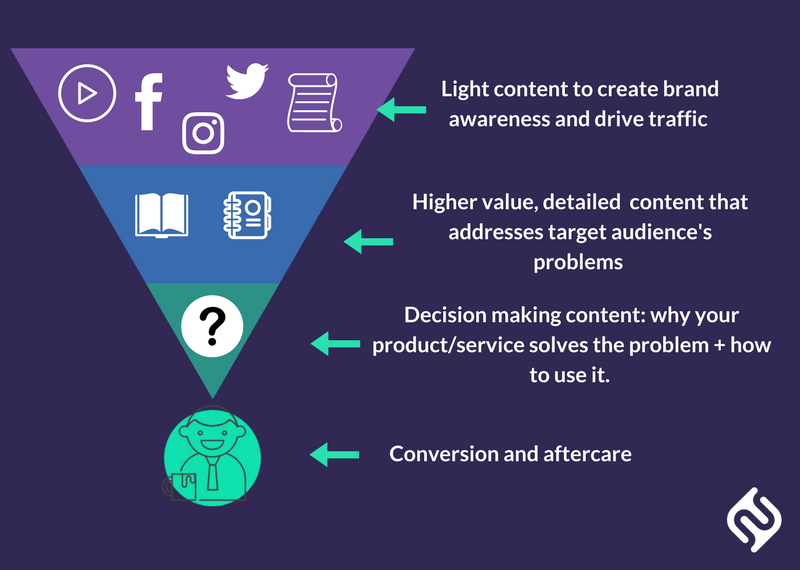
Image via Medium
Typically, I advise the tech startups we create content for to publish at least one piece for each stage of the buyer journey per month. This ensures that they can reach buyers at every stage constantly.
But how do you know what type of content to create for each stage?
There is no standard answer here. Content marketing for tech startups is just as much science as it is art. But there are a few generic options to get you started. Then you can test which option works best for each stage and weed out the content types that are a waste of your time.
Content for the Awareness Stage
SEO and social media (ads) are your best friends here. You want people to discover your brand through educational content like “Top Security Issues for SaaS Companies”.
This is how you can make people aware that they need your solution. And how, ideally, you gain their email address so you can follow up with more in-depth content designed to move them forward on their buying journey.
Content for the interest stage
OK, now you’ve got their attention. They know they have a problem. It’s time to show them that this problem can be easily solved.
You can create:
- SEO content that begins to introduce solutions: “How to Solve all Your SaaS Security Issues” or “Top Tools that Solve SaaS Security Issues”
- Videos and infographics: “Top Must-Haves in a SaaS security tool”
Content for the consideration stage
They’re thinking about buying from you but they’re not sure yet? No problem! Your savvy content strategy will point them the right way.
You can create:
- In-depth white papers that show how your solution is the cutting-edge technology in your industry
- Case studies, testimonials, and reviews — create, promote and encourage existing customers to make their opinion known on your website and third-party websites or social media platforms
- Content that promotes your free trial
- Demo videos — show your solution in action
- Vendor comparisons — why is your technology better than your competitors’?
Content for the purchase stage
Managed to turn a lead into a customer through content? Congratulations — but your work isn’t done yet.
Let’s make sure they stay your client by delighting them and reassuring them they made the best possible decision.
You can create:
- A welcome email sequence thanking them for their purchase and explaining what the next installation/verification steps are.
- Videos, webinars, and how-tos that you can send your clients immediately after their purchase
Content for the upsell/advocacy stage
Could you sell more products to the same client? Reduce your churn rate and increase loyalty through content designed to turn clients into brand ambassadors:
- In-depth whitepapers and e-books for members only — make them feel like VIPs
- Referral bonuses
- Various incentives for participating in your case studies or for leaving reviews on third-party websites
- Surveys asking clients what they would like improved in your solution or what features they might need — your customer service department can help here!
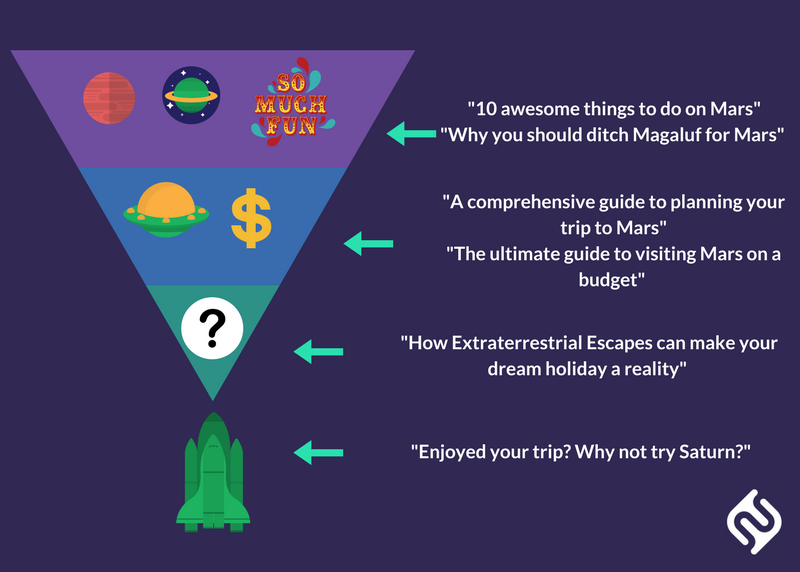
Image via Medium
4. Study Your Competitors’ Content
You don’t want to copy your competitors’ content. But you do want to know what’s out there so you can create better content.
Tools like BuzzSumo reveal the content that’s performing great on a certain topic. You can consider this your starting point.
Remember that you have to deal with both direct and indirect competitors. The direct competitors are other tech startups or established companies that sell similar solutions.
Indirect competitors may not be aiming for a chunk of your market but they are publishing content on the same topics you are.
Following up on the security SaaS example above, you could find blogs like GoDaddy Garage that also tackle security-related topics since they are relevant to their audience.
Now that you know what’s out there, you have to (honestly!) answer a difficult question: can you create better content than your competitors?
Psst, we can help with that! Check out our tech content writing services!
If the answer is yes (or if you’ve chosen to work with us), go ahead and create content that outperforms what’s already out there.
On the other hand, if you feel like there’s nothing more you can add to what’s already been said, don’t waste time on content that’s never going to rank or gain traction.
Instead, focus on what’s not already out there.
For instance, SEMrush‘s Keyword Gap Tool can help you find keywords that are easy to rank for and relevant to your business goals.
5. Create Your Editorial Calendar
Now that you know what topics to tackle, let’s make this a bit more detailed.
Remember what I said above about content marketing for startups needing to be always on-point? Well, you can’t get that without a detailed editorial or content calendar.
Let’s cover the basics of a tech startup’s editorial calendar:
- Don’t get too fancy. A simple spreadsheet with publishing date, content topic, proposed headline, keywords, and type of content is enough
- Map each piece of content to the buyer journey
- Tie each content piece to your business goals — what do you expect your content to do (see above)? You can add this column to your spreadsheet. It will serve as a constant reminder that each piece of content has to be tied to revenue goals.
You can find a free editorial calendar template here. You don’t even need to leave your email address to access it and you can personalize it in any way you want.
6. Start Producing Content
OK, now you know what you’ll be writing about and when you’ll be publishing. It’s time to get to the nitty-gritty of it all — the actual writing.

GIF via GIPHY
Whatever type of content your produce — blog posts, guest posts, emails, social media content, infographics, videos, webinars and so on, you will need to write something. Even videos have a written script.
So you need someone who can actually write.
Whether you decided to do this in-house or hire an agency like Copywritech, you also need to set some writing guidelines. You can include:
- Tone of voice
- Style: friendly, business-like, funny and so on
- Content length
- Acceptable/unacceptable resources to link to
- SEO guidelines
- CTA for each piece of content
- Any mandatory item you want to be included in your content, whether it’s occasional or needed in every piece you produce.
Remember: outsourcing your content writing doesn’t mean you don’t have to be involved in the process at all. Sure, you may get to that point with time but in the beginning, your writing team needs your input.
At Copywritech, for instance, we work closely with our clients for the first months or the first pieces we create for them. After we are confident we know what their content goals are and after they are confident we can produce the type of content they need, we work independently. We can handle every step of their content marketing for startups strategy, from topic and keyword research to content distribution and promotion.
Speaking of which…
7. Content Distribution and Promotion
We’ve already established that even the best of content needs help along its internet journey, right?
Right!
That’s especially true when we’re talking about tech startups. The competition here is fierce.
If you’re a bootstrapping startup then you don’t have the PR budget or the social media reach of a VC- funded startup either.
So your first challenge is to make an impact on a tight budget.
Let’s take a look at the most common tools that shouldn’t be missing from a startup’s content marketing strategy.
a. Social Sharing
As soon as you’ve published a new piece of content, you should create a post on all your social media profiles.
But social sharing is way more than that.
Here are some content marketing hacks that most successful startups use:
- Share more than once: you want to reach your entire audience, right? But they are not all online at the same time. And with social media organic reach on the decline, you will not be able to get to them all with a single post. So schedule your post repeatedly, at intervals that you test regularly — one week, one month, a couple of months and so on. You can do that with each piece of evergreen content.
- Tag people/companies you mention: everyone likes to be quoted. If you used a report from an organization or quoted an influencer in your industry, make sure to tag them on social media. You will get a few retweets and shares and thus expand your reach exponentially.
- Join the conversation: search for hashtags that are relevant to your content’s topic. See any convos that you can add to? Reply with a helpful tip and the link to your new piece of content for people who want to read more on the topic. Don’t spam, though! Join only conversations you can contribute something meaningful to!
b. Social Sharing Off the Beaten Track
There’s the usual social sharing and then there’s the social sharing that not everyone does. This is where disruptive tech startups need to be.
Take a look at this for a second:
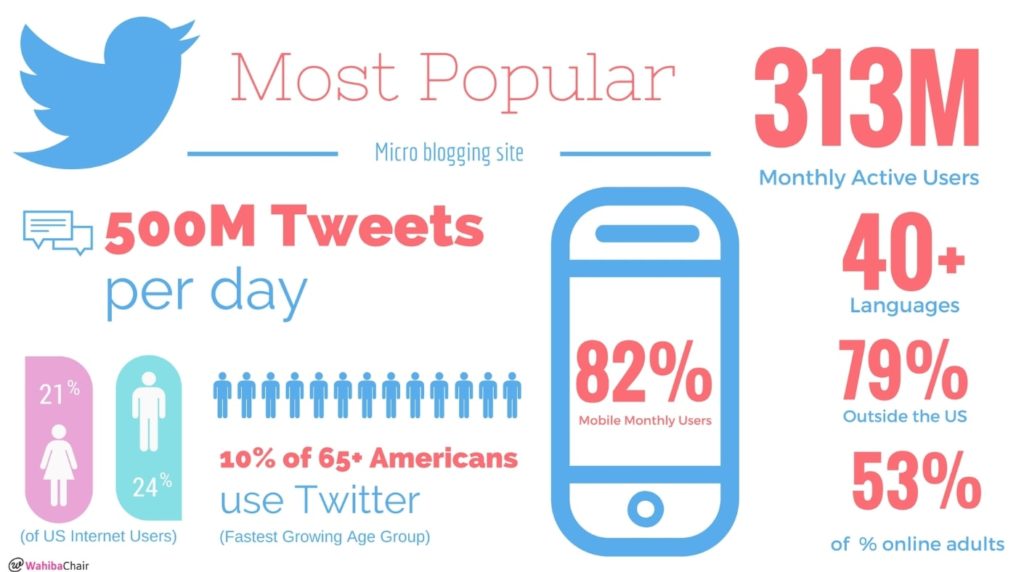
Image via HostSorter
With 500 million tweets published every day, it’s pretty hard to get noticed.
Things don’t look any better for other super-popular social networks like Instagram or Facebook, either.
But then there’s the less known path: smaller, more specialized communities.
Reddit and Quora are two of them.
I know what you’re going to say: they’re not exactly small.
And that’s 100% true.
However, segmentation is much easier on both of them.
There’s a subreddit for ANYTHING, so whatever technology you are selling, you will find your crowd (aka your customers here).
Here’s an illustrative example:

Image via Reddit
There are over 16,000 people interested in chairs underwater. (Did you know that was a thing?)
So you’re bound to find your peeps there too.
You can get new ideas for your startup in a subreddit like r/startups or you can simply search for the subreddit that best matches the description of your technology.
Once again, be careful not to spam. Engage in meaningful conversations and share links only after you’ve offered a summary of what your content is about.
The same goes for Quora. People ask questions about…anything. Probably even underwater chairs.
As a startup content marketer, your job is to find the questions that relate to your business and to answer them in as much detail as possible.
Quora is a great way to gain brand awareness but also backlinks to your content. It does take a bit more time than sharing on Facebook or Twitter but it’s entirely worth it.
c. Email Your Subscribers
Perhaps even before sharing your new content on social media, you should think about the people who specifically said they want to see more of your content — the ones who subscribed to your newsletter.
In fact, you could make this one of the key benefits: ‘subscribe to our email list and be the first to see our new content.’
Emailing your list whenever you publish a new blog post or whitepaper should go without saying but you’d be surprised at how easily people forget the obvious. So consider this your reminder to not forego the simple but prove techniques.
Email has the highest ROI of all digital marketing techniques.
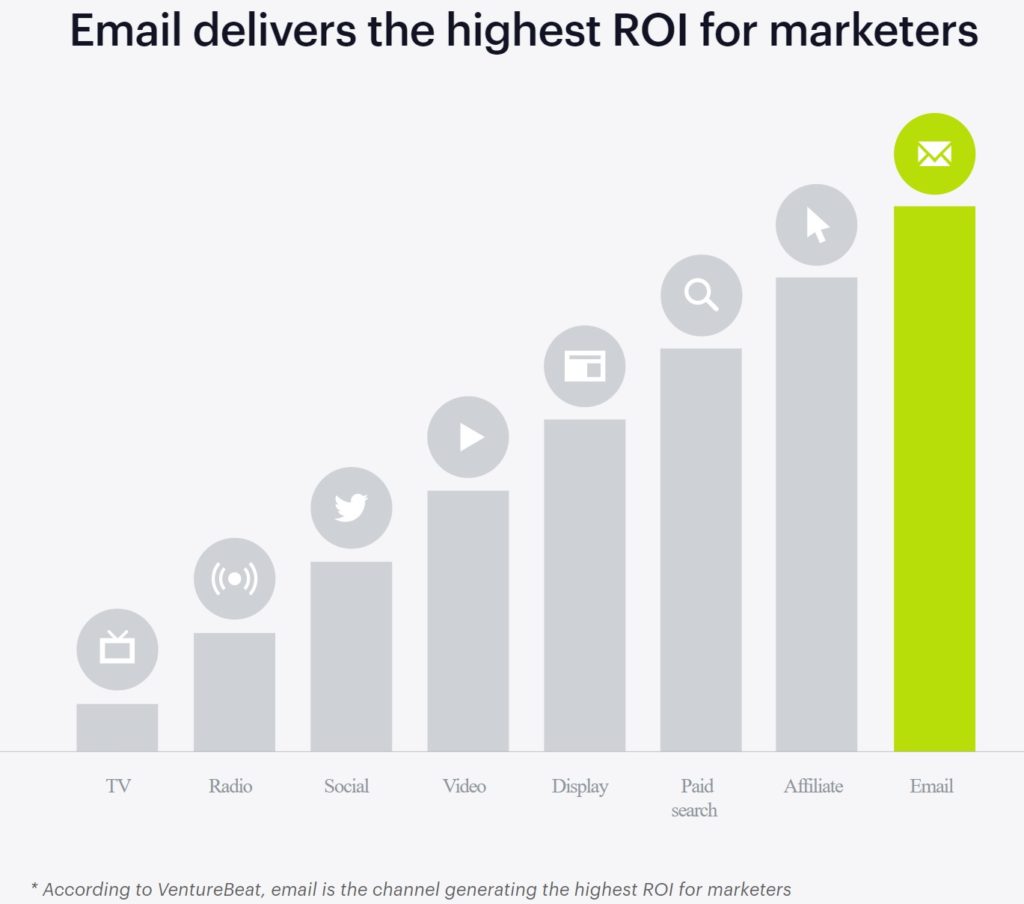
Image via Campaign Monitor
This is why you should start building your email list even before you have a website. While email ROI is unparalleled, remember that these are statistics from email lists that marketers built from scratch, not bought ones.
Whatever you do, no matter how hard it is to build a list for your startup, never buy one. Buying an email list comes with none of the benefits above but with all the perils (even legal ones) and with all the downfalls typically associated with shady marketing practices.
d. Share Your Content in Social Media Groups
Why limit yourself to your social media profiles when you can reach entire communities? Facebook and LinkedIn groups are excellent to get your content noticed.
You can join as a company or use a personal profile (the latter is usually better since everyone prefers interacting with a human who has an actual face). However, don’t join hundreds of groups and simply throw your links everywhere.
Most of the LinkedIn or Facebook groups worth their salt have strict rules about spam. Some create a weekly post where all the members can share what they published in the past week. Others only allow links to members’ websites when someone specifically asks for them.
There is no general rule here.
Your safest bet is to read the rules carefully and abide by them. Or risk getting thrown out.
e. Use Social Media Paid Ads and Remarketing
As tech marketers, we’re all dreaming of the day when our content will get wings of its own and get viral minutes after posting it on social media.
However, this rarely happens for tech startups.
Even the best of content can be buried deep in social media feeds when shared by a new company with a relatively low fan base.
Add the decreasing organic reach of social media to the mix and you’ll understand why you need to help your content along.
After building two brands on quality content alone, I don’t recommend spending too much on paid ads. Just enough to get the engines started. For instance, even a $10 boosted post on Facebook can make a world of difference in your traffic.
Test out various audiences this way and watch your reach increase exponentially — even the organic one.
Remarketing can also be a wise investment. It consists of re-targeting the people that already visited your website. Through cookies, they can see your ads when they are on other relevant websites.
The ideal funnel here would start with social media ads for blog posts then remarketing for premium content like whitepapers or case studies.
f. Use Your Email Signature for Content Promotion
Speaking of easy-to-forget content marketing techniques for startups, the email signature is one of those things that we tend to set and forget.
But think about it for a second: the people you and your staff are emailing are already interested in your technology to some degree. Still, they may not have subscribed to your newsletter and be unaware when you publish a new piece of content.
Your email signature can get them on your website faster than any other channel.
You can opt for a “fixed” signature that you don’t have to change frequently. Something like:
Get the latest from our blog
can do the trick.
Or, depending on the time you are willing to put in, you can:
- Change the signature to a new CTA every time you publish something new.
- Change your signature only when you publish premium content like ebooks, webinars, and whitepapers.
- Slightly change the signature depending on whom you’re emailing — extra personalization never hurts.
g. Inbound Linking to Boost Your Content’s SEO and Views
Want to keep content marketing for your startup within budget? SEO can get expensive fast but there’s one technique that’s 100% free and that you can easily implement.
That’s right, I’m talking about inbound linking.
Inbound linking is the process of adding links to your own content within your content. Yes, that’s very meta but it works because:
- You help your readers discover new content without moving to another website or social media platform.
- Search engines get a better understanding of what your content is about if you link to it from other blog posts using the right anchor (the right anchor is always the main keyword you want the piece you are linking to rank for). For instance, this blog post doesn’t allow me to link to an older post of ours about common API problems and how to solve them. If I want to link to it, I have to create the right context and add a small blurb about API problems and their solutions (see what I did there?).
- When readers stay on your website and move from page to page, your bounce rate decreases. This sends strong signals to search engines that your content is on point and that it deserves to rank higher.
h. Guest Post on Various High-DA Outlets
This is content marketing for startups 101. You don’t have high domain authority. Your brand lacks recognition.
So what can you do?
Write for other outlets that allow guest posting. Make sure that the websites you choose are relevant to your industry and send outreach emails linking to your existing content — to prove you are worth your salt.
Leo Widrich, the co-founder of Buffer, wrote no less than 150 guest posts within nine months. Through guest posting alone, they got more than 100,000 customers in their first month of existence.
At Copywritech, we write guest posts every week and each of the posts published on other websites brings in at least a couple of new leads.
Plus, guest posting can get you the backlinks a new website so desperately needs.
i. Work with Influencers in Your Industry
Ah, yes. Everyone’s favorite topic: influencers.
Whether you love them or hate them, influencers can be a game-changer for tech startups.
As always, you have options:
- Influencer outreach: mention an influencer in your content then tag them on social media or send them an email letting them know you mentioned them. You’ve got excellent odds that they will share your content or even link to it as a thank you.
- Paid influencers: you can reach out to influencers to either ask them to test your solution and write about it or simply share your content with their community.
j. Content Syndication Can Be A Startup Content Marketer’s Best Friend
More traction with less effort? Yes, that’s exactly what content syndication is.
Guest posting is a great way to get your foot in the door and start building some brand authority and domain authority. But you can always pair it with content syndication.
What does it entail?
Briefly put, content syndication means allowing other websites to republish your content. This way, you reach new audiences and gain more backlinks.
Remember the bit about inbound linking above? When someone else publishes your content, they do it with the links you have added. Thus, you gain backlinks automatically with virtually zero effort on your part.
k. Submit Your Blog Posts to Content Communities
Content communities are a great way to spark some conversation around your content. Again, balance is key here: don’t publish everything you write on all the communities you know. Be selective and publish only relevant pieces.
And an additional tip: add a personalized summary instead of simply copy-pasting your intro. Perhaps ask the community’s opinion or create a CTA that determines people to click on your link.
The two communities we use frequently for both our agencies and for our clients are:
- Hacker News for tech topics
- Growth Hub for marketing topics
l. Repurpose Existing Content
Published a great blog post? Congratulations!
Also, sorry to be a nitpicker but not everybody has the time or the patience to read a few thousand words on any given topic.
But they might consume your content if you repurposed your post in an infographic or a slideshow.
This is what content repurposing is all about: keeping the information but re-packaging it in various other formats.
Some examples:
- A webinar can be turned into a series of blog posts
- A whitepaper can be turned into an ebook, a webinar or a series of blog posts
- Several blog posts on similar topics can become topic clusters or ebooks
- Your latest feature release article can become a how-to video.
This article has more ideas on how to repurpose content, so give it a read before deciding you’ve reached the ROI limit of your latest piece.
Content Marketing for Startups — Final Thoughts
Most of the tech startups we’ve worked with approached content marketing with a single clear goal in mind: to beat their competitors.
Sounds about right.
Except they were planning to beat those (already established, mind you) competitors at their own game and using their weapons.
Competitor X is blogging 10 times per month. We’ll do 11.
Competitor Y doesn’t use social media ads. We won’t either.
Competitor Z doesn’t have a blog. Why would we create one?
See the problem here? You can’t have your own distinct voice and steal your competitors’ customers if you’re doing exactly what they’re doing only slightly better.
As a tech startup, you innovate. Why not innovate your content marketing too?
Studying the competition is mandatory in any industry. But when you dwell too much on what they do, you lose the ability to leverage your content marketing innovation abilities.
At Copywritech, we empower our customers to break new ground and innovate in marketing as much as they do in technology. Thus, we make sure that their content marketing supports and reflects their business goals 100% of the time.
Still not sure how to tackle content marketing for startups? That’s what we’re here for! Fill in the form below, tell us a bit about yourself and we’ll be happy to help you with strategy, content creation or content promotion.
Let’s talk about your business goals!
2 Comentarii la “Content Marketing for Startups – The Step-By-Step Guide for Tech Companies”
[…] when you create something for your SaaS content marketing strategy, talk to your product managers and engineers. Ask them if they can associate their own creation […]
[…] when you create something for your SaaS content marketing strategy, talk to your product managers and engineers. Ask them if they can associate their own creation […]